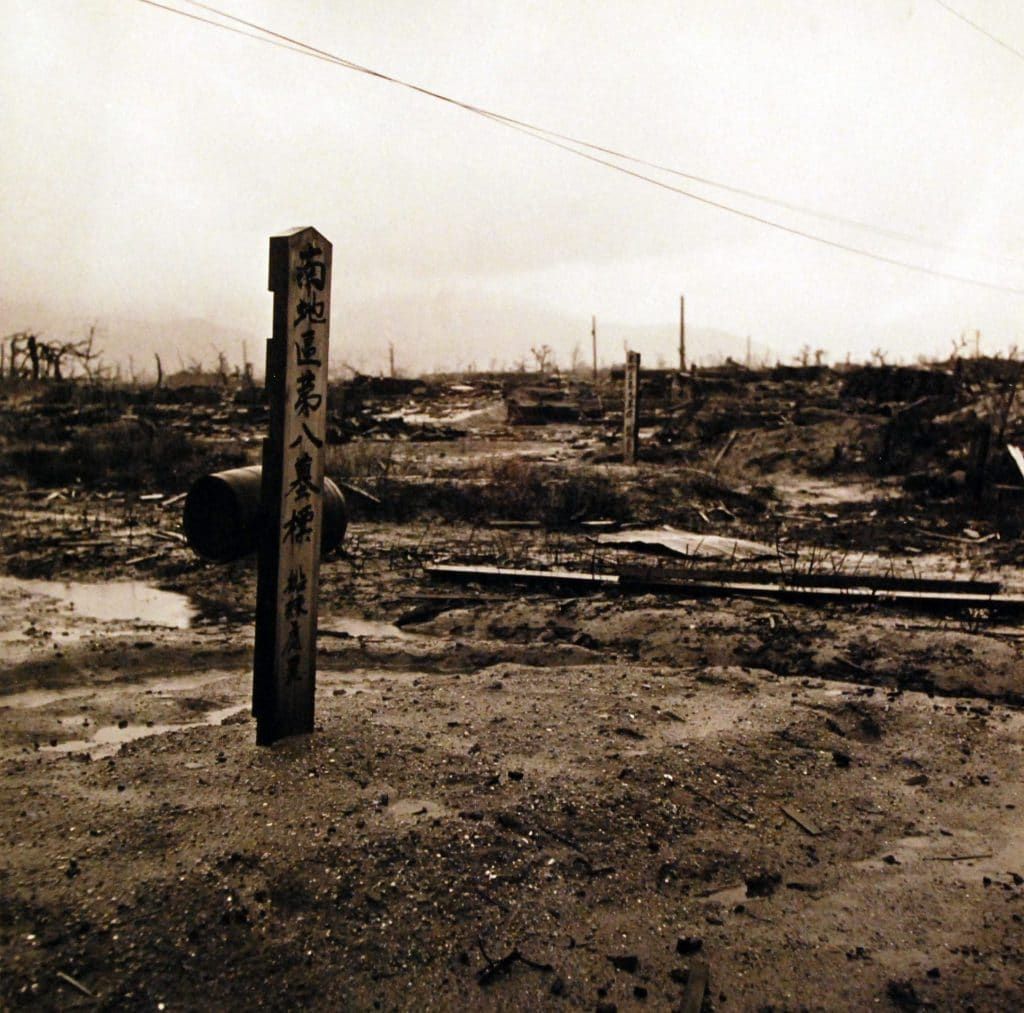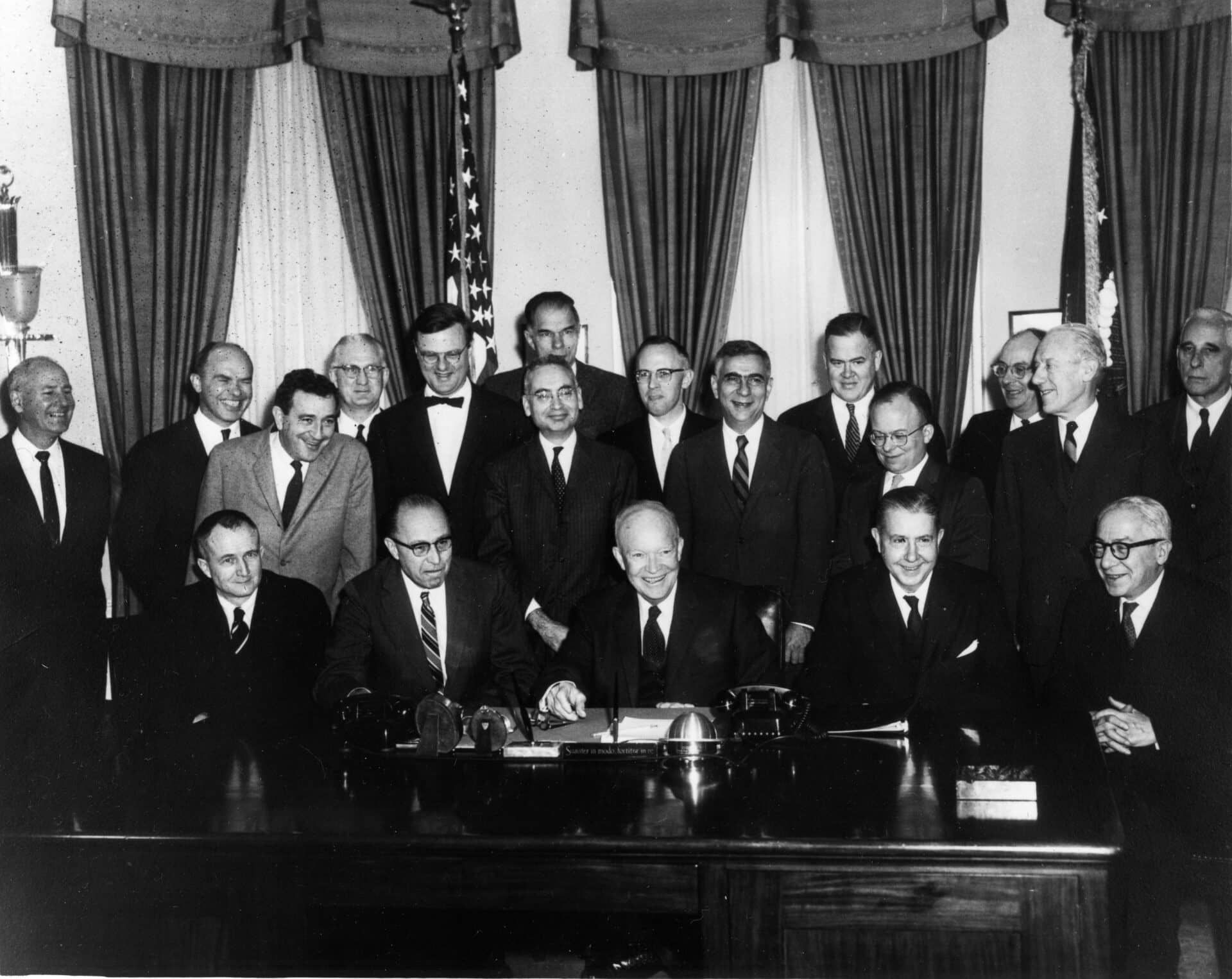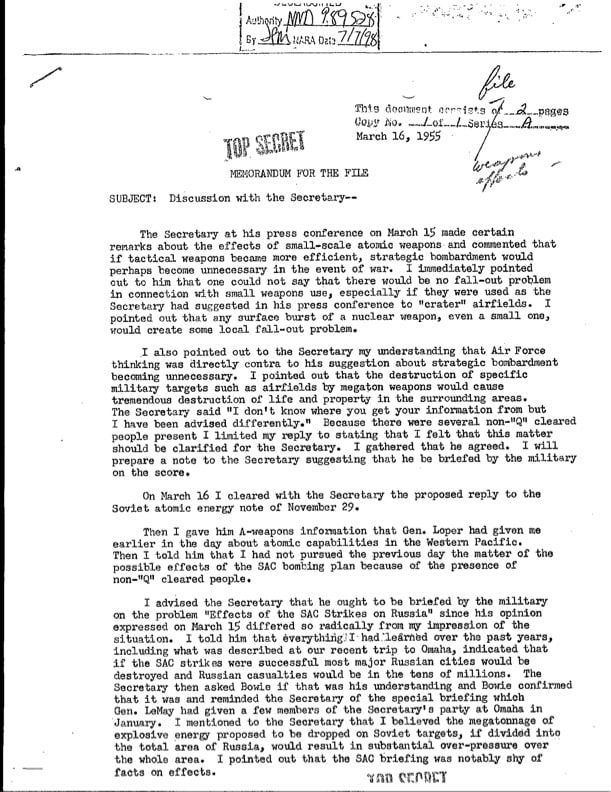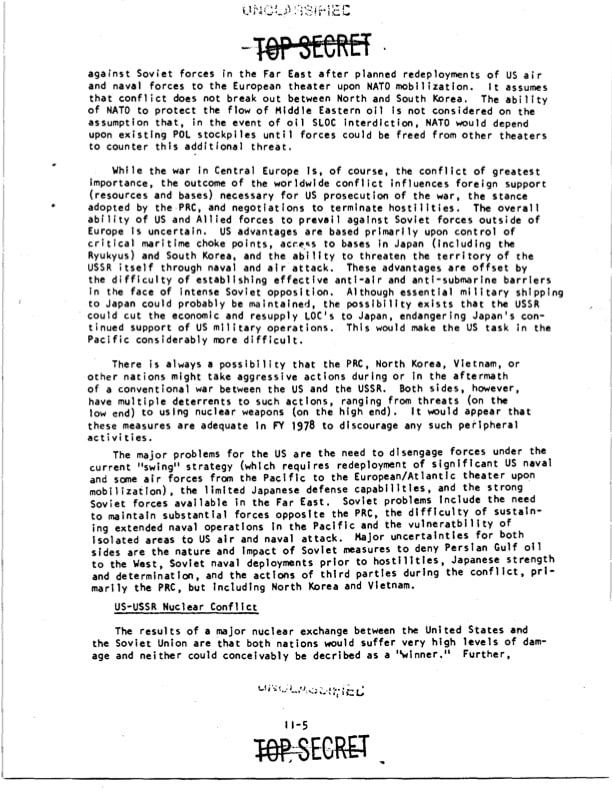Cold War estimates of deaths in nuclear conflict
By William Burr | January 4, 2023
 Mass grave markers in Hiroshima, photographed by Lieutenant Wayne Miller in September 1945. (US Navy / National Archives)
Mass grave markers in Hiroshima, photographed by Lieutenant Wayne Miller in September 1945. (US Navy / National Archives)
Apprehension about Russia’s war against Ukraine has produced speculation about the possibility of limited Russian nuclear strikes against targets in that country. Especially worrisome is the danger of a local conflict escalating quickly into a major nuclear exchange between Russia and the United States and other NATO countries. However unlikely that prospect, a large-scale nuclear war involving countries with strategic nuclear forces could cause huge numbers of fatalities and injuries in addition to the losses produced by climactic impacts. A recent study in the journal Nature projects a catastrophic 5 billion deaths.
Once nuclear weapons became a significant element in US military force structures and planning, beginning in the late 1940s, government agencies began estimating nuclear war fatalities. Over the years, fatality estimates—usually classified top secret—were embedded in nuclear war plans, strategic force requirements, strategic balance assessments, and arms control decisions. The estimates, which often left out important effects of nuclear detonations, sometimes conveyed the shifting “balance of strength” between the two superpowers. The magnitude of these numbers sometimes shocked US officials, who eventually sought options intended to make nuclear war less catastrophic.
While a considerable number of important estimates from the 1950s, 1960s, and 1970s have been declassified, government agencies have refused to declassify other fatality numbers, and estimates from the 1980s and beyond remain unavailable. With the war in Ukraine once again raising the prospect of a nuclear war, accurate estimates of such a war’s human impacts are more important than ever. But it is not even clear whether the US government continues to make such estimates.
Cold War calculations. Casualty estimates were part of the war planning effort from the beginning, a recognizable element of ascertaining the impact of nuclear strikes on a given country or set of targets. Estimates made during the late 1940s projected millions of deaths from atomic bombings. By the mid-1950s, with thermonuclear weapons becoming available, deaths in scores of millions became certain. These hydrogen bombs were “area weapons” that could destroy large cities and their surroundings, or large areas around military targets.
With thermonuclear weapons becoming integral to the US arsenal, government officials drew a frightening picture of their effects. In 1959, David Z. Beckler, executive director of President Dwight D. Eisenhower’s Science Advisory Committee, declared that the radioactive fallout from an all-out US-Soviet nuclear war would cause “enormous” numbers of casualties, but they “would represent only a small portion of the total casualties from all causes (blast, thermal radiation, fire, and local fallout).”

The work of the National Security Council’s highly secret Net Evaluation Subcommittee supported Beckler’s conclusions. As part of its effort to gauge the overall impact of nuclear strikes on each side, the subcommittee prepared casualty estimates. In its 1958 report, the subcommittee imagined a devastating Soviet attack in 1961 involving the detonation on the United States of 553 nuclear weapons with a total yield exceeding 2,000 megatons—more than 130,000 times as powerful as the atomic bomb dropped on Hiroshima, which had an estimated yield of 15 kilotons. An estimated 50 million Americans would die, with nine million sick or injured, out of a pre-attack population of 179 million. The US retaliatory attack would include every city in the “Sino-Soviet” bloc with a population of over 25,000. It would completely destroy “command facilities” in Moscow, Beijing, and Pyongyang and kill 71 million people at once; 30 days later, a total of 196 million people would be dead (out of a population of 952 million people in the bloc).
According to the report, the US counterattack “would virtually eliminate [the Soviet Union] as a world power.” As devastating as this picture was, the report nevertheless found that at the end of the nuclear exchange, “[t]he balance of strength would be on the side of the United States.” That confidence would erode as the Soviet Union’s capability to inflict deaths and destruction increased during the 1960s.
Military planning. Estimating of deaths and destruction went hand in hand with US nuclear planning. As the Cold War developed, and atomic weapons became a bigger part of the US arsenal, military planners and civilian authorities began preparing for the possibility of a confrontation. For that worst case, a failure of deterrence in which war was imminent and civilian authorities were ready to authorize nuclear weapons use, military officials developed plans to use these weapons—either in retaliation or preemptively—to destroy the adversary’s key military and industrial installations. In that context, Soviet nuclear weapons sites (delivery systems and stockpiles) became prime targets, as did civilian and military headquarters and key industrial facilities.
Beginning in the late 1940s and early 1950s, target planners developed methodologies to estimate requisite levels of destruction for targets. Usually, explosive blast effects were the chief metric for measuring destruction.
To obtain the desired outcome, target planners assigned warheads and delivery systems, and collaborated with military commanders to develop tactics for optimizing destruction. By 1960, war planning was centralized at the Joint Strategic Target Planning Staff, located at the headquarters of the Strategic Air Command in Nebraska. The planning staff had responsibility for preparing the Single Integrated Operational Plan, the US warfighting strategy for the use of nuclear weapons.
A 1961 report by the Joint Chiefs of Staff exemplified the potentially catastrophic impacts of the operational plan’s targeting. The report included estimates of casualties associated with a military conflict over West Berlin. According to numbers drawn from the war plan, a full-force attack on the Soviet Union’s major cities, government control centers, and nuclear threat targets would kill some 50 percent of its total population—some 108 million out of its then-population of 217 million. If the smaller alert force (with bombers on 15-minute to two-hour alert) was used, total Soviet casualties would be 37 percent, or about 80 million.
The total estimated deaths, including Chinese, from a full-force attack, 212 million, were fewer than the estimate of 600 million that the Joint Chiefs provided to the Kennedy White House in 1961, as disclosed in jaw-dropping detail by Daniel Ellsberg. The revelation of these startling numbers was important, but the documentary record is elusive. (Significant Pentagon records from the early 1960s remain unprocessed at the National Archives, so the document may be found someday.)
Estimates of fatalities were also built into decision making on strategic and defensive force levels. For example, in 1962, Secretary of Defense Robert McNamara explained to President Kennedy why he rejected Air Force proposals for a first-strike capability. McNamara observed that the latest estimates showed that in a projected 1968 nuclear conflict a strategic strike by the Air Force’s proposed force would leave 100 surviving Soviet intercontinental ballistic missiles. If the Soviets targeted those missiles against US cities, “they could inflict roughly 50 million direct fatalities in the United States, even with fallout protection.” That was not an “‘acceptable’ level of damage.” Kennedy let McNamara’s recommendation stand.

Shifts in strategic balance. Over the years, fatality estimates reflected the changing strategic balance. During the 1950s and the early 1960s, estimated Soviet fatalities were proportionately higher than US fatalities. As Soviet strategic forces caught up in their lethality, however, estimated US fatalities markedly increased, and optimism about a “balance of strength” favoring a post-nuclear-war United States faded.
Exemplifying the catastrophic scale of destruction and the growing numbers of estimated US fatalities was a 1967 interagency report describing the comparative vulnerabilities of the United States and the Soviet Union. According to the report, in 1964 the Soviets could kill 48 million Americans in a preemptive attack; by 1968, with greater numbers of intercontinental ballistic missiles in place, they would be able to kill 91 million.
By contrast, Soviet fatalities remained relatively constant during the decade, because the United States already had large strategic forces by 1964. In a US retaliatory attack on Soviet cities in 1964, some 77 million would be killed, the report estimated. Under the same circumstances, 81 million would be killed in 1967.
A “political-psychological” burden. While all the estimates were conjectural, some admittedly were underestimates. The authors of a 1969 study prepared for strategic arms control talks estimated scores of millions of fatalities on both sides but acknowledged that they “underestimat[ed] the resulting fatalities.” They based their appraisals on fatalities caused by explosive blast damage and did not include impacts such as radiation and mass fires, which were certain to cause many more deaths.
When Secretary of State John Foster Dulles was briefed in 1955 on the destruction that thermonuclear weapons would inflict, he was initially incredulous. Dulles had to be re-briefed before he accepted the analysis.

The prospect that decisions to use nuclear weapons would cause tremendous death and ruin troubled US officials. As Deputy Secretary of State Elliot Richardson put it years later, there was a “political-psychological” issue: “the imbalance between [the] ability to inflict fatalities and [the] reluctance to accept or cause large numbers of deaths.” Well before then, US presidents and their advisers had become strongly averse to nuclear weapons use, with the “nuclear taboo” stigmatizing these weapons because of the terrible and disproportionate dangers that their combat use would cause.
Huge casualty estimates and the enormous scale of nuclear strikes influenced President Richard Nixon to seek alternatives to apocalyptic attacks, eventually leading to a 1974 directive calling for options to control escalation and limit the scope and intensity of destructiveness. During the following years, the Defense Department tried to break down the operational plan into smaller attack options (Major, Regional, and Selective) to give the president and command authorities less destructive and possibly more credible options. But into the 1980s the options developed by the planning staff continued to require large numbers of nuclear weapons, despite attempts by presidents to scale back the plans.
Presidents Carter and Reagan successively levied explicit requirements for reduced “collateral damage”—civilian casualties—in their targeting policy directives (Presidential Directive 59 and National Security Decision Directive 13, respectively). While target planners prepared still-classified studies on collateral damage, their impact is unknown. It was not until the late 1980s, when the Cold War was winding down, that the White House and Pentagon officials induced target planners to produce attack options that could reduce deaths and destruction. What planners actually did—for example, whether they adjusted target planning to reduce “collateral” damage to civilians—is highly secret. In any event, it’s unclear whether any estimates of casualties were produced.

Secrets and risks. The horrifying scale of fatalities estimated during the 1950s through the 1970s were classified for years, only becoming available through archival releases during the 1990s and later. With rare exceptions, nuclear casualty estimates from the 1980s or later years are unavailable. Indeed, in some instances, the Defense Department has refused to declassify estimates in reports from the 1960s and 1970s.
While non-governmental organizations such as International Physicians for the Prevention of Nuclear War and Physicians for Social Responsibility have produced casualty estimates, the degree to which official projections continued into the post-Cold War period is unclear. In 2013, the Obama administration began to apply to nuclear targeting international rules of war presented in the 1977 Protocol I to the Geneva Conventions, such as proportionality and civilian-military target distinctions. The adoption of those rules in 2013 may have led to estimates of fatalities under more restrictive targeting options, but that is also unclear.
The dangers of superpower war and nuclear confrontation declined when the Cold War ended, and both the United States and the former Soviet Union/Russia made significant cuts in their strategic forces. In recent years, with tensions increasing and the future of Ukraine and Taiwan in dispute, risks have risen again.
Adding to the danger is the Indo-Pakistan nuclear arms race. Both countries have engaged in risky confrontations with significant escalatory potential; the perils of a nuclear conflict between India and Pakistan are grave, and the overall impact would be disastrous. The recent catastrophic flooding of Pakistan, made all the worse by climate change, may influence that country’s security priorities.
The war against Ukraine presents a newer danger. It can only be hoped that the leaders of nuclear weapon states avoid steps that would make Cold War nuclear casualty estimates more than historical curiosities.
Correction: The Joint Chiefs’ 1961 estimate of total deaths—disclosed in Daniel Ellsberg’s 2017 book The Doomsday Machine—was roughly 600 million, not 275 million as originally published. The latter estimate did not include all deaths in China, the Soviet Union, and Soviet satellites.
Together, we make the world safer.
The Bulletin elevates expert voices above the noise. But as an independent nonprofit organization, our operations depend on the support of readers like you. Help us continue to deliver quality journalism that holds leaders accountable. Your support of our work at any level is important. In return, we promise our coverage will be understandable, influential, vigilant, solution-oriented, and fair-minded. Together we can make a difference.
Keywords: balance of strength, fatalities, nuclear war
Topics: Analysis, Nuclear Risk, Nuclear Weapons















There aere loads of significant material in this article but in the very first paragraph Burr neglects that the US has NOT renounced ‘first use.’ He also disarms us with “However unlikely –a large scale nuclear war…” We’ve had Presidents who have gotten us into deadly wars. Our previous President was self-serving and dangerous. Biden’s mental state is far from certain. WWI blew up out of mistakes and some arrogance. There are Nukes in the hands of 9 countries and many parked in other countries such as Netherlands, Germany, Italy… Accidents, malice, self serving behavior, or plain nuttiness could trigger… Read more »
As an historical description, this article is very interesting. But I don’t see any discussion of more recent casualty estimates incorporating the secondary devastation due to nuclear winter, which would result from the soot and dust added to the upper atmosphere by the initial detonations and subsequent fire storms.